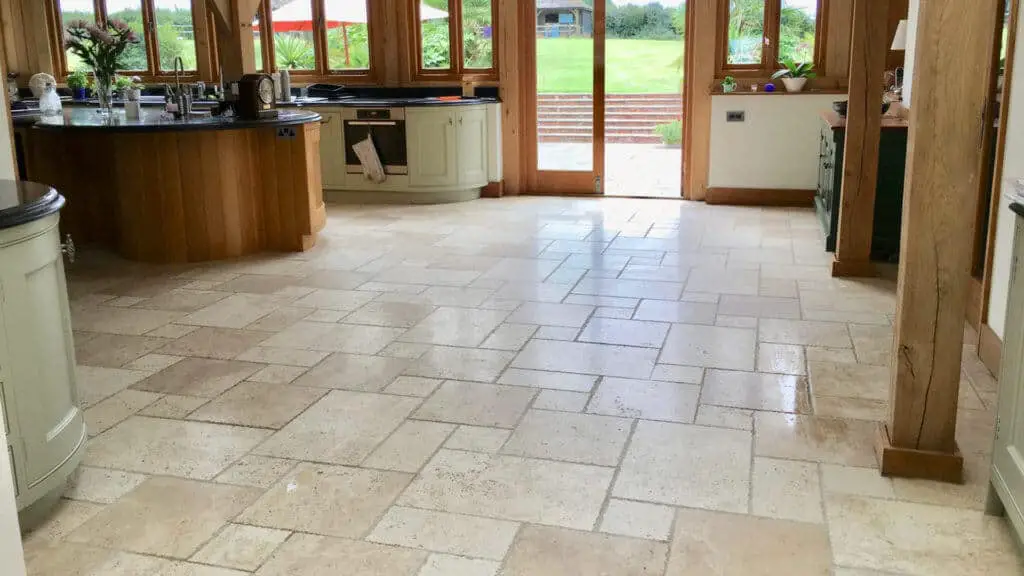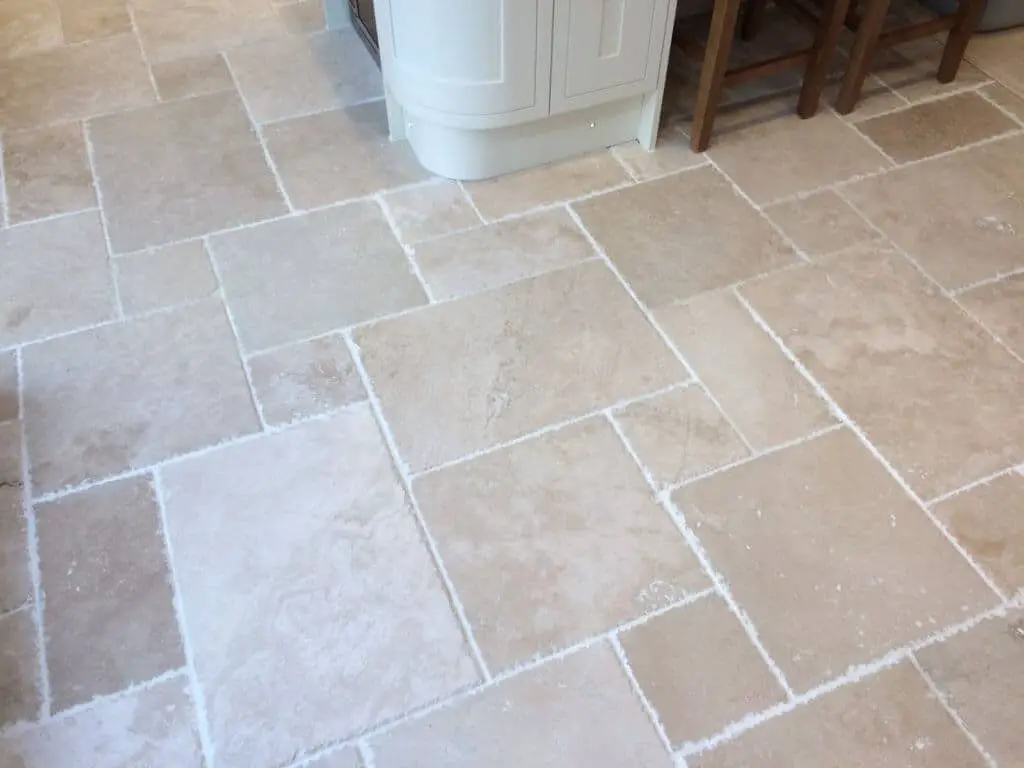Travertine is a natural stone floor just like Marble, Onyx, Limestone, and Slate. It is found around in areas with mineral deposits like hot springs and limestone caves and has a marble-like quality. Travertine is very beautiful and uplifts the look of any room it is installed in.
However, like any other type of flooring, proper and frequent maintenance is paramount in order to preserve the floor’s beauty and lifespan.
We will cover all the best ways to keep your travertine floor tiles and shower tiles. In this article, we’ll discuss how to clean travertine flooring and get it looking brand new!
Read: Steam cleaning travertine flooring
How to Clean Travertine Flooring
Table of Contents
Maintenance
You need to set a weekly routine for sweeping and vacuuming your travertine floor. Disinfecting and grout line cleaning should be monthly or every other month, depending on how dirty your floor gets.
It’s very important to set a cleaning schedule to enable you to regularly clean your travertine floor; this helps to prevent dirt and debris from settling down and become deeply embedded into the pores.
Over time, existing holes can fill with dust and dirt, causing the floor itself to look dirty. In addition, new holes can start to appear on your floor due to everyday wear and tear, which can cast a dirty shadow, causing the floor to look dirty, even when it is clean.
When cleaning your travertine floor, you also want to clean the grout lines alongside, Grout lines are easily ignored, but without the grout lines, the travertine tiles will be left vulnerable to damage as they leave an open space for the buildup of dirt, moisture, and grime, which can seep underneath the pores of the tiles.
If your grout lines are badly damaged, they can be fully replaced or removed, but again, applying a sealant during the initial installation process is the best way to prevent future grout trouble.
Another way to also maintain your travertine floor is by placing rugs in high traffic areas. The rug will help to prevent debris and dirt particles from scratching the flood surface.
Seal Your Travertine Flooring
Some travertine floor comes pre-sealed, some do not. In order for your travertine Floor to keep looking like brand new, it is important that a sealant be applied. You can determine if your floor needs sealing or not by carrying out a simple test.
Simply apply a small amount of water to the surface and check to see If the water is absorbed by the floor and it darkens; if it does, that means your floor needs resealing, but if the applied water starts to roll and form a bead on the floor surface, the floor is sealed.
The usefulness of sealing on a Travertine flooring cannot be overemphasized. It is one of the best ways to keep your travertine flooring in immaculate condition.
Travertine flooring is well-known as a permeable rock with microscopic pores that make it prone to damage, discoloration, staining, and it aids the growth of mold, so it is very important that you get your flooring properly sealed with a good quality sealant as this will help to increase the lifespan of your flooring.
Make use of the right kind of sealant for your travertine floor because using a low-quality sealant could be as detrimental to your floor as no sealant at all.
There are two types of sealants that can be used for your floors; there is the penetrating one and the surface sealer. The former will seep into your tiles holes and obstruct them, thus preventing the accumulation of dust or liquid.
The latter will create a barrier on top of the floor, which will stop the entrance of moisture or dirt and also reduces the chances of staining or discoloration.
If your floor is unsealed, you will need to c check for the tile manufacturer’s recommendation and then purchase the very best sealant in your budget.
Do’s and Don’ts when Cleaning Your Travertine Floor
Travertine might be a strong stone, but it has porous pores; this makes it quite sensitive. Here are a few things to keep in mind before cleaning your floors:
Do’s
Clean your floor surface using a soft sponge and hot water to wipe up crumbs and small messes. Use a stone cleaner or any regular cleaning soap once in a while for bigger messes. Frequent use of different cleaning agents on Your Travertine flooring will dull the surface with soap film.
Clean up spills immediately they happen; this is because travertine floors are very sensitive to acidic substances like tomato sauce, soda, wine, coffee, and cleaning products that can dull the finish or stain the floor surface.
Before choosing any product for your travertine floor, whether it is for cleaning or sealing or polishing product, testing the product out is very important. There are a variety of different cleaning products that may or may not be suitable for your travertine floors.
Therefore it is important to always try the product on a small inconspicuous section of the flooring and see if it causes any reaction. Once you’ve seen the reaction of the product and you are fully satisfied with it, then you can proceed to use it on your travertine floors.
Don’ts
Many commonly sourced cleaning products contain acids, alkalis, and other chemicals can dull or damage the countertop or floor surface or, worse; degrade the sealant, thereby leaving the stone vulnerable to staining
Don’t use a generic bathroom, tile, or grout cleaner. The cleaning powders and even the “soft” creams contain abrasives that leave scratch marks and dull the surface.
Read: Can vinegar ruin your grout
Don’t use a soaked mop to clean your travertine floor; try to Wring out as much water as you can until the mop is just slightly damp. A soaked mop can damage your flooring by causing water infiltration.
Cleaning Process Preparation
Regardless of the type of travertine floor cleaner, you intend to use, putting on some protective clothing will help you get into the nooks and crannies of the floor surface.
Read: Homemade Floor Cleaner
Protective clothing like a pair of gloves and wrap around glasses will prevent dust or even the cleaning solution from flying up and into your eyes.
As stated earlier, always test a cleaner on a small inconspicuous section of the floor to see its reaction; this helps to ensure that your cleaning solution won’t damage or discolor the floor.
If you intend to use your hand to scrub the floor, you have to keep in mind that the detergents in cleaners can get under fingernails and cause skin irritation as you clean. Have a toothbrush with soft bristles ready for those stubborn stains that can settle into grout grooves.
A stack of clean towels or rags will come in handy for cleaning the residue formed by the cleaning agents in order to achieve a beautiful and shiny travertine floor.
Cleaning Your Travertine Floor
Now that you know what not to do and how to go about the cleaning procedure, let’s get down to work;
Direction
First, using a broom, gently sweep the floor, and collect all the dirt and debris in a dustpan. Sweeping before mopping will make the entire process faster and cleaner.
You can also make use of a dust mop with a microfiber head for this step.
Next, you need to prepare your cleaner. You can make use of only warm water for this or add a couple of squirts of your favorite cleaning agent and mix thoroughly.
Grab your mop and dip it inside the bucket of cleaning mixture or just warm water, wring out the excess until the mop is just slightly damp. If you have a spin mop, you can make use of it, since you can wring out all the water from the mop without using your hands.
You can also make use of a spray mop if you have one, so you just spray the warm water or soapy mixture in front of the mop and wipe it with the mop head. It makes the cleaning process a lot easier.
Gather all your elbow grease and start mopping; it is recommended that you start from the farthest end of the room and work your way towards the door; this way, you don’t have to step on your newly mopped floor while trying to exit the room.
After mopping, get a bucket of clean cold water and repeat the same mopping process you did with the warm water. Remember to change the mopping water as soon as it gets dirty.
Finally, after rinsing the area with clean water, use a soft cloth or towel to dry the floor. Drying your travertine floor after mopping not only prevents the formation of streaks, it also eliminates any chance of standing water and helps to preserve your floor and give you your desired results.
Read: How to clean matte porcelain tile
Cleaning Travertine Flooring Grout Lines
The grout lines between the travertine floor allow for the expansion and contraction of the material during seasonal temperature fluctuations; this prevents individual pieces of tiles from rubbing into one another and cracking.
However, it can also be the most vulnerable point in your travertine flooring installation, as these spaces are susceptible to water penetration, stains, discoloration, and the growth of dark, unsightly, and unhealthy mold.
To the grout lines, mix equal parts baking soda and water to create a gritty paste. This can be scrubbed onto the grout with a small brush, that will allow you to wash the areas between the tiles without scratching their edges and causing damage to the floor itself.
This process can be done fairly thoroughly and easily as the grout itself will not etch or damage under pressure.
Read: How to buff tile floors
Conclusion
Travertine floor gives your space a very unique and earthy look. However, although they seem tough, this type of flooring is very delicate, and knowing how to clean travertine flooring properly is very paramount in increasing its lifespan.
With travertine flooring, less is more! You do not need any fancy and expensive special cleaning products; all you need at most is just water.


